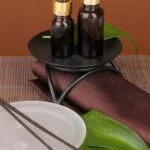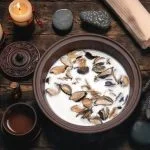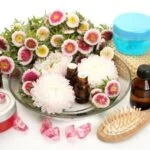Aromatherapy, a practice that involves the use of essential oils for therapeutic purposes, has been around for centuries. But where did aromatherapy originate? The origins of aromatherapy can be traced back to ancient civilizations such as Egypt, Greece, and Rome, where fragrant oils were used for their healing properties and aromatic benefits.
The term “aromatherapy” itself was coined in the 20th century by French chemist René-Maurice Gattefossé, who discovered the healing properties of lavender oil after an accident. Since then, aromatherapy has gained popularity worldwide for its holistic approach to health and well-being.
Aromatherapy involves the use of essential oils extracted from plants to promote physical, emotional, and mental health. These oils are often used in massage therapy, baths, inhalation, and diffusion methods to address various ailments and enhance overall wellness. Whether it’s relieving stress, improving sleep quality, or boosting immunity, aromatherapy offers a natural alternative for self-care and healing.
Early Beginnings
Aromatherapy, as we know it today, has a rich history that dates back to ancient civilizations. The origins of aromatherapy can be traced back to early civilizations where aromatic plants and oils were used for both medicinal and spiritual purposes. The use of fragrant oils and botanical extracts was prevalent in these societies, laying the foundation for what would later become known as aromatherapy.
To understand the historical origins of aromatherapy, we must look at the practices of ancient civilizations such as Egypt, Mesopotamia, Greece, Rome, and India. These cultures revered the natural scents of plants and recognized their therapeutic properties. In Egypt, for example, aromatic substances were used in religious ceremonies and healing rituals. The Egyptians were known to use essential oils extracted from plants like frankincense and myrrh for embalming their deceased pharaohs.
In Mesopotamia and India, aromatic herbs and spices were utilized in traditional medicine to treat various health conditions. The practice of using aromatic plant materials for healing purposes continued to evolve over time in different regions around the world. This early exploration of the healing power of scents laid the groundwork for the development of modern aromatherapy practices that we benefit from today.
Ancient Civilizations and Aromatic Practices
Aromatherapy has a rich history that dates back to ancient civilizations, where aromatic practices were deeply embedded in their cultures and daily lives. The origins of aromatherapy can be traced back to early civilizations such as Egypt, China, India, and Greece. These ancient cultures recognized the healing properties of plants and herbs, which laid the foundation for the development of aromatherapy as we know it today.
In Ancient Egypt, aromatic substances played a significant role in religious ceremonies, medicinal practices, and even in the embalming process. Essential oils like frankincense, myrrh, and cedarwood were highly revered for their therapeutic benefits and were used for both physical and spiritual healing purposes. The Egyptians believed that these fragrant oils could purify the body, mind, and soul.
Similarly, in Ancient China and India, aromatic herbs and oils were used in traditional medicine systems such as Traditional Chinese Medicine (TCM) and Ayurveda. These ancient healing practices focused on restoring balance within the body by using natural remedies derived from plants. The use of essential oils in massage therapy, herbal remedies, and perfumery was widespread in these cultures long before modern aromatherapy became popular in the West.
| Ancient Civilizations | Aromatic Practices |
|---|---|
| Egypt | Religious ceremonies, medicinal practices |
| China & India | Traditional medicine systems like TCM & Ayurveda |
The Role of Essential Oils
Essential oils have played a significant role in the practice of aromatherapy throughout history, with various cultures around the world harnessing the healing properties of fragrant oils for physical, mental, and spiritual well-being. The use of essential oils dates back to ancient civilizations where aromatic plants were valued for their medicinal properties and therapeutic benefits.
These precious oils were extracted through methods like distillation, pressing, or maceration, and were used in a wide range of applications including perfumes, medicines, religious rituals, and personal care products.
Ancient Egypt: Pioneers in Aromatic Healing
One of the earliest known civilizations to embrace the use of essential oils for healing purposes was ancient Egypt. The Egyptians were renowned for their extensive knowledge of botanicals and aromatic substances, utilizing oils such as frankincense, myrrh, rosemary, and cedarwood in various medical treatments and embalming practices.
Essential oils were also incorporated into religious ceremonies and daily life rituals due to their perceived sacred and purifying qualities. The Ebers Papyrus, one of the oldest surviving medical texts from ancient Egypt, contains numerous references to herbal remedies and aromatic preparations used for ailments ranging from digestive issues to skin conditions.
Ancient Greece and Rome: Aromatics in Medicine
The civilizations of ancient Greece and Rome furthered the understanding of aromatherapy by incorporating essential oils into their medical practices. Greek physicians like Hippocrates recognized the therapeutic benefits of aromatic herbs and oils for treating illnesses and promoting overall wellness. The renowned physician Galen also documented the use of fragrant substances in his pharmacological writings.
In Rome, renowned figures such as Pliny the Elder highlighted the importance of aromatics in medicine and hygiene. The legacy of these early Mediterranean cultures laid the foundation for future advancements in aromatherapy practices across the globe.
Influence of Traditional Chinese Medicine and Ayurveda on Aromatherapy
Traditional Chinese Medicine (TCM) and Ayurveda have played significant roles in shaping the practice of aromatherapy as we know it today. Both systems have long-standing histories of utilizing aromatic substances for healing purposes, dating back thousands of years. These ancient traditions laid the groundwork for the modern understanding and application of essential oils in aromatherapy.
Traditional Chinese Medicine (TCM): Aromatic Herbal Medicine
In TCM, the use of aromatic herbs and plants has been an integral part of healing practices for centuries. The concept of “qi,” the vital energy that flows through the body, emphasizes the importance of balancing energies to maintain health. Aromatherapy is often used in conjunction with other TCM modalities such as acupuncture and herbal medicine to restore harmony and promote well-being. Essential oils like ginger, lavender, and peppermint are commonly used in TCM for their therapeutic properties.
Ayurveda: The Science of Life and Aromatherapy
Ayurveda, considered one of the oldest holistic healing systems in the world, also incorporates aromatherapy into its treatment approach. In Ayurvedic philosophy, each individual has a unique mind-body constitution known as doshas (Vata, Pitta, Kapha), and maintaining a balance among these doshas is key to good health.
Essential oils like sandalwood, rose, and jasmine are used in Ayurveda to help balance doshas, alleviate symptoms, and enhance overall well-being. The practice of Abhyanga, or self-massage with herbal oils, is a common Ayurvedic ritual that includes aromatherapy benefits.
The influence of Traditional Chinese Medicine and Ayurveda on aromatherapy is undeniable, as these ancient healing systems have provided valuable insights into the therapeutic properties of essential oils and aromatic substances. By incorporating principles from TCM and Ayurveda into modern aromatherapy practices, practitioners can create holistic treatment plans that address both physical and emotional imbalances.
The wisdom passed down from these ancient traditions continues to shape the way we understand and appreciate the art of using fragrant oils for healing purposes today.
Revival of Aromatherapy in the Modern Era
Aromatherapy has a rich history that dates back thousands of years, with its origins rooted in ancient civilizations. However, it was not until the modern era that aromatherapy experienced a revival and transitioned from being used primarily for perfumes to becoming known for its therapeutic benefits. This shift in perception and utilization of essential oils marked a significant turning point in the practice of aromatherapy.
During the 19th and early 20th centuries, there was a resurgence of interest in natural remedies and alternative healing practices. Aromatherapy gained popularity once again as people rediscovered the powerful effects of essential oils on physical, emotional, and mental well-being. It was during this time that scientists and researchers began to study the properties of essential oils more closely, leading to a deeper understanding of how they could be used therapeutically.
The modern era saw the development of new methodologies for applying aromatherapy, including diffusers, topical applications, inhalation techniques, and even incorporating essential oils into massage therapies. As scientific research continued to support the efficacy of aromatherapy in promoting relaxation, reducing stress, improving sleep quality, and even providing relief from certain ailments, its use expanded beyond traditional practices. Today, aromatherapy is widely recognized as a holistic approach to wellness that complements conventional medicine.
- Revival of interest in natural remedies
- Development of new application methods
- Expanding use beyond traditional practices
The Pioneers of Modern Aromatherapy
Gattefosse accidentally discovered the healing properties of lavender essential oil when he used it to treat a burn on his hand. This serendipitous event led him to further explore the potential applications of essential oils in healthcare.
Another pioneer in the field of aromatherapy is Marguerite Maury, an Austrian biochemist and aromatherapist who is credited with popularizing the use of essential oils for holistic healing. Maury developed unique massage techniques that incorporated essential oils to promote physical and emotional well-being. Her work laid the foundation for the use of aromatherapy in spa treatments and beauty care.
Additionally, Robert Tisserand, an English aromatherapist and author, played a significant role in educating the public about the safe and effective use of essential oils. Tisserand’s book, “The Art of Aromatherapy,” remains a seminal text in the field and has helped establish guidelines for using essential oils responsibly.
His advocacy for quality standards and proper dilution ratios has been crucial in ensuring that aromatherapy is practiced safely and ethically. These pioneers have truly paved the way for modern aromatherapy practices, shaping its evolution into a respected form of natural healing therapy.
Aromatherapy Today
Aromatherapy has evolved over the course of history from its ancient roots to its modern-day popularity. Today, aromatherapy is a widely recognized holistic healing practice that involves the use of essential oils to promote well-being and health. From relaxation to skincare, aromatherapy has found its way into various aspects of people’s lives, offering natural remedies for a wide range of physical and emotional ailments.
One of the most popular practices in aromatherapy today is the use of essential oils for stress relief and relaxation. Essential oils like lavender, chamomile, and eucalyptus are commonly used in diffusers or massage oils to help reduce stress, anxiety, and promote relaxation. Many people also incorporate essential oils into their self-care routines by adding them to baths or creating personalized blends for aromatherapy sessions at home.
In addition to stress relief, aromatherapy is also gaining popularity in the field of skincare. Many beauty and wellness companies are now incorporating essential oils into their products due to their natural healing properties. Essential oils like tea tree oil for acne or rosehip oil for anti-aging benefits have become staples in many skincare routines. This trend highlights the growing awareness of using natural ingredients in personal care products and the shift towards a more holistic approach to skincare.
| Aromatherapy Today: Popular Practices | Trends in Aromatherapy |
|---|---|
| Essential oils for stress relief and relaxation | Increasing use of essential oils in self-care routines |
| Essential oils in skincare products | Rising demand for natural ingredients in beauty industry |
Conclusion
Aromatherapy has a long and rich history that dates back to ancient civilizations where fragrant oils were used for medicinal, spiritual, and cosmetic purposes. Throughout the centuries, different cultures have incorporated aromatic practices into their healing traditions, paving the way for the modern use of essential oils in aromatherapy. From Egypt to India to China, the use of aromatic plants and oils has been deeply rooted in traditional medicine systems.
In modern times, aromatherapy has experienced a revival with a shift towards more therapeutic uses rather than just perfumery. The pioneers of modern aromatherapy have contributed significantly to its development and recognition as a legitimate alternative healing practice. Names like Rene-Maurice Gattefosse and Marguerite Maury have played crucial roles in popularizing aromatherapy and establishing its foundations based on scientific research.
Today, aromatherapy continues to grow in popularity as people seek natural remedies for various ailments and ways to improve their overall well-being. With ongoing research supporting the benefits of essential oils, the future of aromatherapy looks promising.
As we look back on the history of aromatherapy and its evolution over time, we can appreciate the diverse cultural influences that have shaped this practice into what it is today. Whether used for relaxation, stress relief, or physical healing, aromatherapy holds a unique place in holistic health care that is both ancient and modern at the same time.
Frequently Asked Questions
Where Did Aromatherapy Come From?
Aromatherapy has its roots in ancient civilizations like Egypt, China, and India. The Egyptians used essential oils for embalming and religious ceremonies. In China, aromatherapy was practiced as part of Traditional Chinese Medicine.
Who First Started Using Essential Oils?
The use of essential oils can be traced back to the ancient Egyptians, who were known to use them for various purposes including medicinal, religious, and cosmetic reasons. They were considered precious commodities even back then.
What Cultures Use Aromatherapy?
Various cultures around the world have incorporated aromatherapy into their traditional practices. For example, in India, Ayurveda uses essential oils for holistic healing. In Europe, aromatherapy gained popularity in the 20th century thanks to pioneers like Rene-Maurice Gattefosse and Jean Valnet. Today, it is a widely used form of alternative medicine globally.

Are you looking for a natural way to improve your health and wellbeing?
If so, aromatherapy may be the answer for you.





